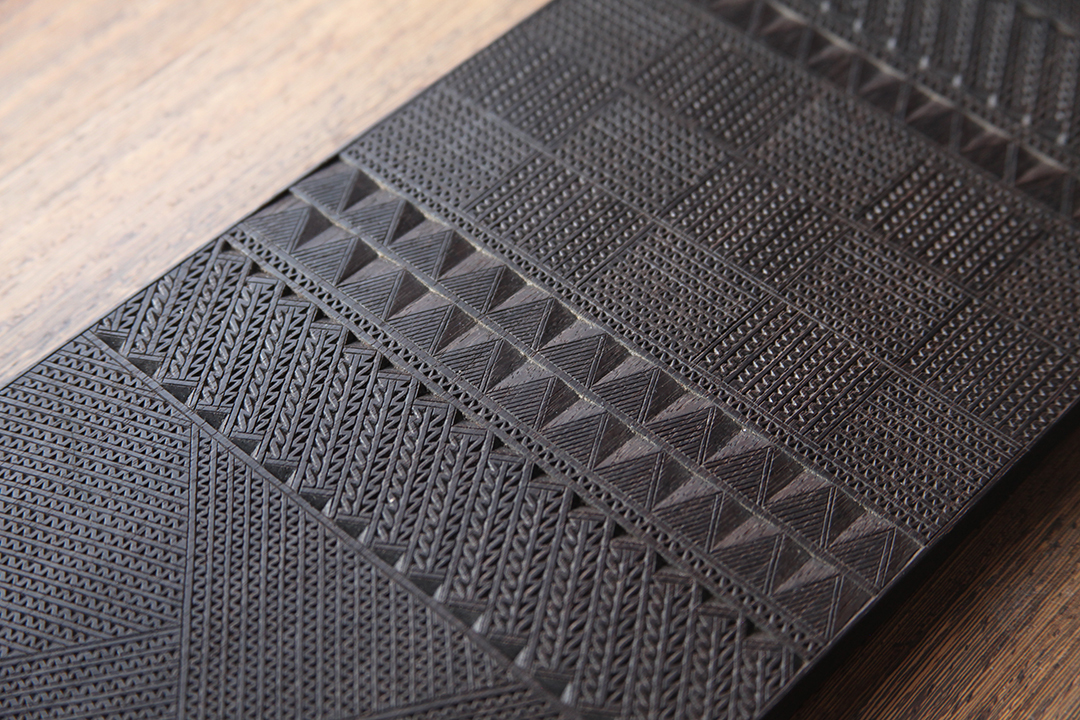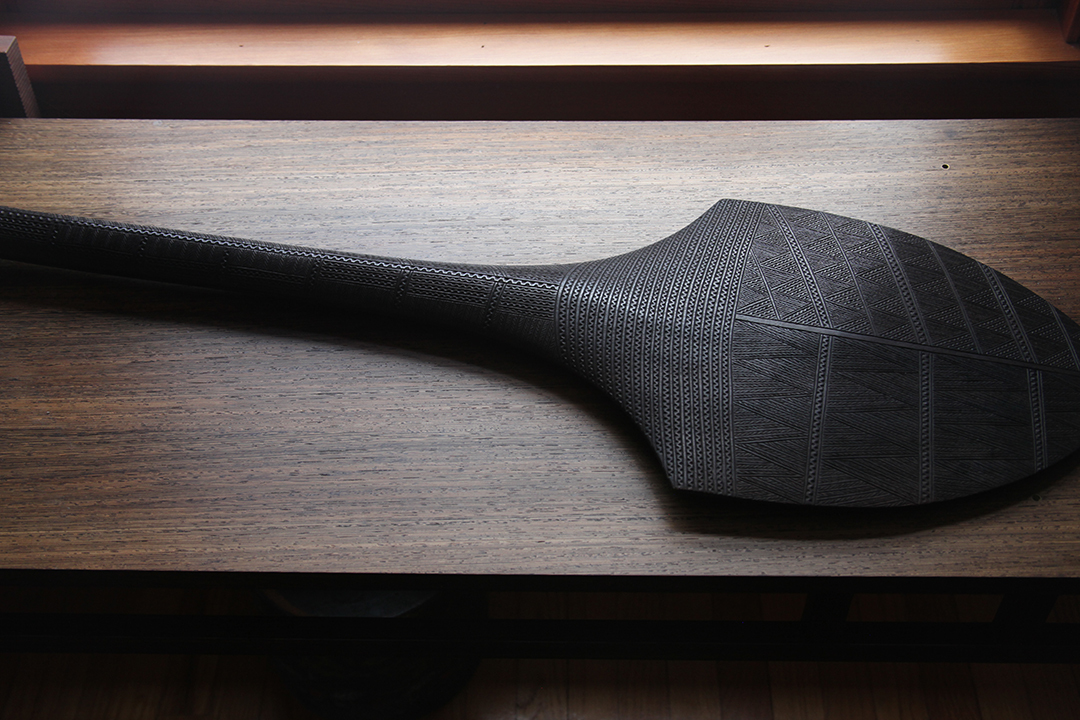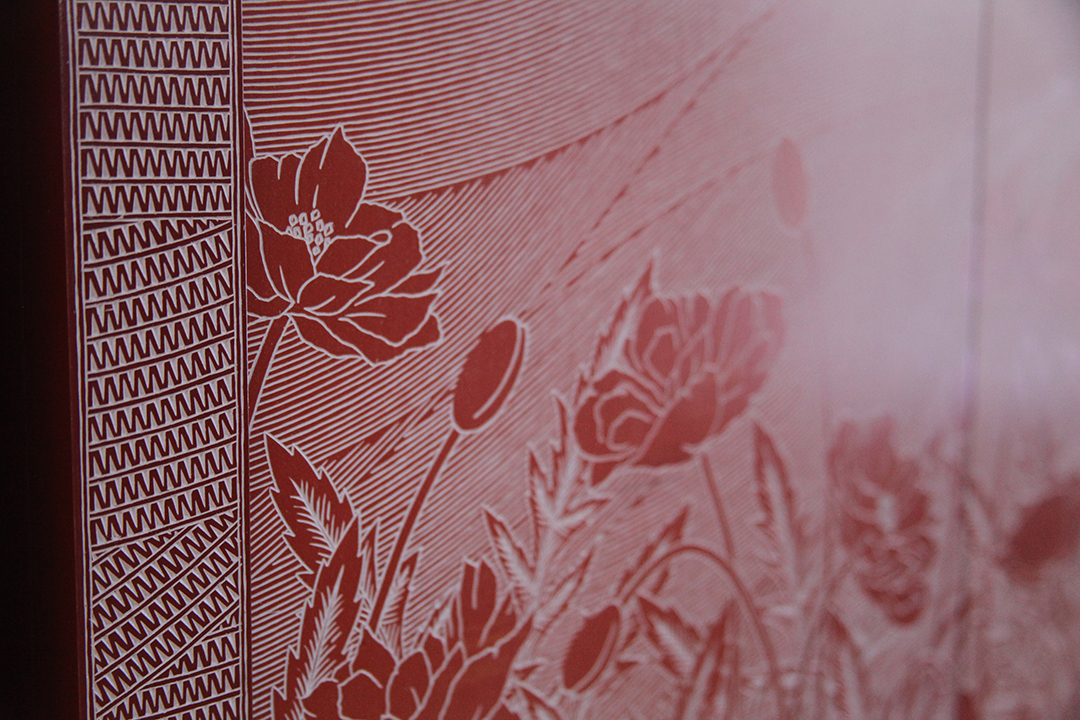Deirdre Visser in conversation with Kristina Madsen
Deirdre Visser sat down with Kristina Madsen to talk about her life, her career as a maker, and why she loves to carve.
Visser is currently co-authoring with Laura Mays a history titled, Making a Seat at the Table: Women Transform Woodworking, which will be published by Routledge in 2021. This essay draws on the lengthy interview Visser did with Kristina Madsen in January 2020, research for the larger book project.
In fall of 2019, Mays and Visser co-curated an exhibition by the same title, Making a Seat at the Table, that opened at The Center for Art in Wood in Philadelphia; the exhibit featured the work of 43 women and gender non-conforming makers.
Below is a version of this interview.
“I carve because I love it. I’m quite consumed by it; I love pattern making.” ‑Kristina Madsen

Kristina Madsen, sample carving done in Fiji, 1991
Throughout time and across cultures humans have decorated surfaces. We have a natural, innate desire for decoration. My work is one link in this ever-lengthening chain of tradition.
In mid-January 2020 I sat down with Kristina Madsen in Western Massachusetts in the kitchen of the house in which she grew up. An uncommonly warm winter, there had finally been some snow the night before, and a few inches of fresh powder articulated the bare branches of the deciduous trees lining rural roads as I drove west in my very red rental car. Folks were out shoveling their walkways and driveways, occasionally waving to a neighbor. It was crisp but not too cold, the long rays of winter light throwing shadows on the picturesque New England house when I pulled into the drive.
Twenty-eight years ago, Madsen moved back to this home to care for her parents. After her father died, her mother needed more care, so she settled in and built a shop for herself about thirty paces from the home where she and her mom lived. Madsen’s parents, both of whom had grown up in the Southampton area in families involved in agriculture, tended the land around their home and sustained a large garden, putting up food each fall for the family to get through the winter, a tradition she maintains today. She is the steward of her family’s acreage, and she and her sister are in the midst of creating a conservation easement for land that feels sacred to her.
Childhood/Family life
Neither parent was a woodworker, but the women on Madsen’s mother’s side were dexterous, skilled craftswomen in various kinds of needlework and textiles. In addition to a gifted and mentoring grandmother, Madsen had three great-aunts — also on her mother’s side— who were models of independence, pursuing education and professional careers, and traveling around the world. Aunt Erna, in particular — who attended Columbia University — was an advocate for her grand-nieces’ education and an influential role-model.
“My mother was a needleworker of the highest order,” Madsen recalled. “She did exquisite work, and she set me to stitching when I was a little girl. I was using all the needles, sewing needles, knitting needles and the like, so I’ve always been inclined toward handwork and precision.
“Fabric is as much of an interest to me as wood is,” Madsen says of her eventual material development. “The wood has come to dominate, but they’re very interrelated. And the carving is now quite similar to some of the more rhythmic stitches, like the knitting or crocheting. It’s very repetitive and quite meditative. You just get into the flow of it.”
In high school Madsen became very involved in the art and theatre programs. When the time came to do her senior independent study, though she’d never taken carpentry or woodshop, she initially sought a woodworker with whom to study, but couldn’t find one. When I asked her what her impulse towards woodworking had been, she replied, “I have no idea! It was just a hunch….I was 17. There’s no accounting for it….I had no familiarity whatsoever with fine furniture building.
“Then the year after high school I met (master woodworker) David Powell in a bar,” she continued. “A mutual friend actually talked him into taking me on. He was a little timid about it to begin with; he was afraid of the liability, someone working on machines… When he asked me what I wanted to build, I told him a wheelbarrow and a ladder. Go figure.” With one semester of university education under her belt, Madsen was hooked. Once she started, there was no going back. Powell, who had trained with Edward Barnsley, had a small shop in an old potato barn in Hatfield, Massachusetts, outfitted with hand tools, a work bench, and a table saw. “For the first two years, I just used hand tools because that’s what he was trained on,” Madsen recalls. “Barnsley’s shop just had a treadle circular saw, and everything else was hand tools. You can see in his tool chest all of that lineage.”
In her first apprentice year, Madsen was making pieces Powell had designed. From a hand-sawn octagonal cutting board she moved to a bookcase and then a coffee table before finally making a chest. “I was hugely fortunate to have studied with David,” she says. “He was very demanding. I think one reason he gave so much to me was because he could see that I had the inclination for precision and that I was focused and persistent.” In the second year Madsen completed a type case of her own design for a bookbinder.
After the second year of taking on apprentices, Powell (now Powell and [John] Tierney Woodworkers) formalized the training program as Leeds Design Workshops. Madsen spent two more years working under Powell’s guidance before she started in a teaching capacity herself. With twenty students at a time, Madsen remembers that there were never more than two or three women in a class. Though today one is an architect, Madsen isn’t aware of any that are still working in wood. Reflecting on the educational experience at Leeds, Madsen suspects that the women in the program likely had the same experience of their reserved and unapproachable yet “stunningly skilled” instructor that their male peers had.
Madsen emerged as a maker into the world that was rich with opportunities. The studio furniture movement was blossoming: Galleries along the eastern seaboard were mounting exhibitions, and the marketplace offered opportunities for commission, representation, and collection. Except for one summer in her early twenties when she worked as a seamstress, Madsen has made her living as a furniture maker. Although she’ll tell you that it’s a good thing she didn’t need much, it’s nevertheless an extraordinary and rare accomplishment.
“I had opportunities — I think we all had opportunities — that people getting into the field today don’t have. Museums and newly-opened galleries were mounting exhibitions that included the work of young makers. There was a great sense of camaraderie throughout the growing field, especially amongst the small group of women makers. For instance, one year, ’83, Wendy [Maruyama] and Rosanne [Somerson] and I all were residents at Art Park in New York. We were there as friends and coworkers during that time. It was really lovely to be part of that small group. When I think back to those opportunities we had as young makers in a developing field, I don’t believe young people today have the same opportunities to launch their careers.”
Learning Fijian Carving

Makiti Koto, Kini Kini (paddle club), 1988
At 20 or 21 years old, living in a Northampton apartment, Madsen was lent a catalog that would shape the rest of her life as a woodworker. It was large, a coffee table-sized book of the Oceanic Collection at Chicago’s Field Museum. This was her first exposure to the exquisite carving of the Pacific island region northeast of Australia. “I would pore through that borrowed book,” she recalls. “I eventually found a copy for myself…and then, when I was invited to the University of Tasmania, I [went] to New Zealand on my way over and Fiji on my way back: 10 days in New Zealand, a week in Fiji. That was an extraordinary opportunity,” she says. “I was saturated with that work and really pursued it.” In Fiji Madsen was introduced to a carver named Makiti Koto and arranged to spend a day with him in his village. When Madsen returned to the States shortly thereafter, a friend encouraged her to apply for a Fulbright Grant. Without a college degree, she applied in the “at-large” category, which recognized makers or scholars with ten or more years of experience in their field of practice. She received the award and went back to Fiji in 1991 to work with Makiti for nine months.
In the complex intersection of personal relationships in a global and colonial political and economic landscape, an American’s presence afforded some economic and social capital to Makiti’s family. In his forties and with a young family, Makiti spoke English fluently, had traveled to New Zealand and the West Coast of the US, and was willing to take on a young and enthusiastic American. Madsen spent five months with him on the main island of Viti Levu, and another three in his home village on Fulaga, one of only two Fijian islands where carving is done.
“We worked in the shade under his house [built on pilings]. Often, there were one or two other carvers working with us. Makiti was a great storyteller and as we carved, he schooled me in nai vakarau vakaviti (the Fijian way). On Fulaga, where traditional mores were still intact, I couldn’t carve with the men, so I sat and carved next to Makiti’s mother. I was quite a curiosity to all of the villagers, who were patient with me as I made plenty of blunders navigating village life.”
In addition to studying the language, Madsen was doing as much reading in the library as she could take in, and absorbing Makiti’s conscious efforts to help her understand Fijian culture and history. She returned from her Fulbright experience in February 1992, building a new body of work, all carved. The relationship formed that Fulbright year changed both of their lives creatively and personally. It’s clear that she’s as enlivened today by the possibilities of carving as she was when she first fell in love with that catalog of Oceanic carving.
Patterning and Process
With her history of stitching and needlework, it’s no surprise that when Madsen started to make furniture with carved surfaces, textiles served as her primary pattern reference. Nowadays, botany is also a major design source. “Pattern work is ancient; it’s everywhere in nature, complicated, beautiful patterns. We’re surrounded by them,” she says. While in Fiji, Madsen met a professor at the University of the South Pacific who introduced her to the book Symmetries of Culture which, she says, became “one of my primary sources of pattern research. It’s a mathematical analysis of plane pattern; all symmetries have a formula that can be applied to them. I couldn’t read the book because it was pure mathematical analysis of pattern, but it’s rich in imagery. Many of the early patterns on my post-Fiji work were influenced by Oceanic patterns, tapa cloth in particular.”
Completely intertwined and designed simultaneously, Madsen’s furniture design and fabrication — in physical demand and quality of time — are distinct from the energy and focus required for the carving. While she uses the furniture form on which to carry out the carving, she also loves the furniture aspect — building and problem solving. Sometimes the idea of the pattern comes first, and sometimes it’s the furniture piece that first takes shape in Madsen’s imagination. Never easy, Madsen describes it as brain strain. “I have to work really hard to get a project going. The building is active, upright. I’m moving around all the time. And then, when I get to the carving stage, I’m sitting for weeks or months at a time, and it’s very focused and more tiring,” she explains. Little of the carved pattern is drawn onto the completed furniture form; in fact, often she draws only the layout in broad strokes, later doing the thought-intensive work of refining it. “The final effect of light reflecting off of the carved facets is never completely apparent until the last coat of finish is on it. There’s always some surprise. Always.” The recently completed Poppy Cabinet beautifully demonstrates the way she works to combine the furniture form with the carved pattern.


Kristina Madsen, Poppy Cabinet, 2019 (r. drawer front for the cabinet base)
Forty years into her career, Madsen is making work that is more ambitious than ever. They’re large pieces, complex in structure and extraordinarily intricate in detail. And, while remaining passionately engaged in the shop, in the last couple years other opportunities have been enticing. When Pritam and Eames — the gallery that had represented Madsen for 25 years — closed its physical space in 2017 and moved entirely online, an anchor for studio furniture was lost. The closing propelled Madsen to consider new paths. She contemplated returning to school to pursue the degree she’d left behind years ago. Yet after exploring various options, she realized there is still too much she wants to do in the woodshop. She set her sights on an exhibition that will combine completed pieces held by private collectors, and a series of new works. “I have a limited amount of time to pull this off; it’s now or never. I’m excited. We’ll see where I can take it.”

Deirdre Visser is Curator of The Arts at CIIS in San Francisco and publisher of CHROMA books. As curator, educator, and publisher she strives to promote pluralism in the arts, to support artists in the creation of new work, and to foster dynamic and critical dialogues within and across communities that propose integrative approaches to the urgent questions we collectively face. Visser’s work aims to connect history to the present, ethically and strategically, to look for common themes and deepen our understanding of both past and present as we move into the future.
“I am indebted to Kristina Madsen for spending a wonderful long afternoon with me last January, sharing countless stories as well as the warmth of her kitchen and home cooking. That unforgettable experience provided an anchor for this writing and for the shared editing process.
I am also grateful to my co-author, Laura Mays, and to Carla Williams, our astute and exacting editor.”